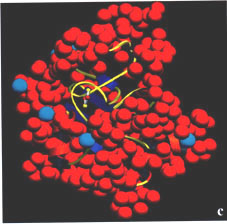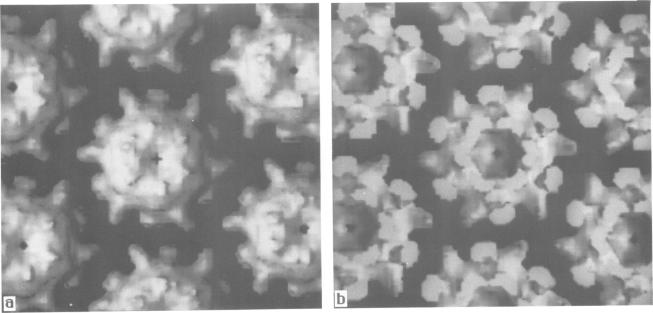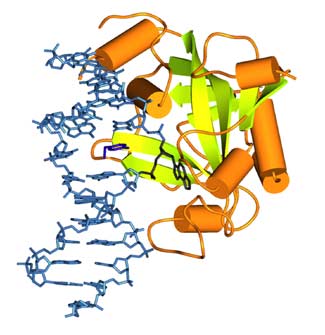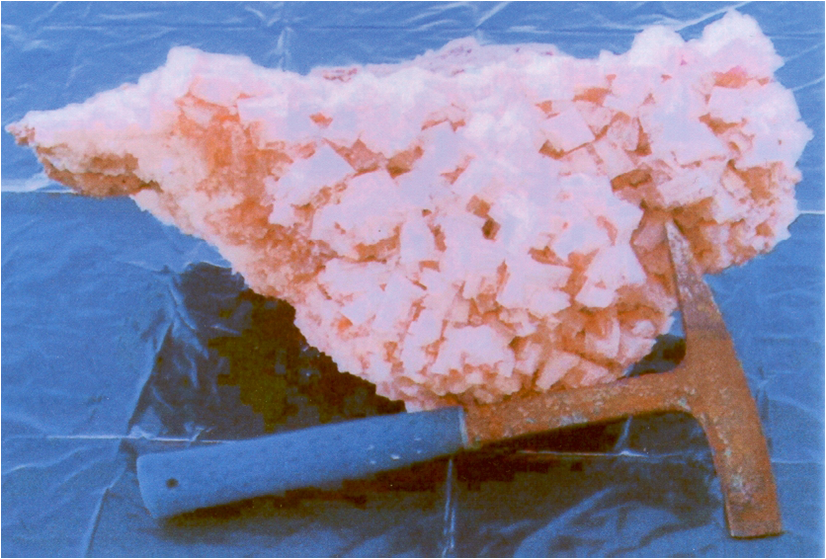Halobacterium volcanii
| Halobacteria volcanii | ||||||
|---|---|---|---|---|---|---|
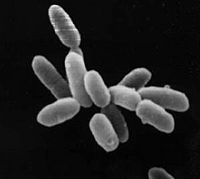 | ||||||
| Scientific classification | ||||||
| ||||||
| Binomial name | ||||||
| halobacterium volcanii |
Also known as Haloferax volcanii
Description and Significance
Haloferax volcanii is an archaeon that can survive in environments of extreme salt concentrations. Halobacteria are located throughout the world in salt ponds and lakes, and may exist in the form of dormant or living cells, biopolymers in rocks, salt crystals, or as evaporates in desert regions.[1] Haloferax volcanii in particular resides largely in the bottom sediment of the Dead Sea (and is the predominant organism there), and are distinct from other organisms in their class in a few ways.[2] H. voclanii has a certain halophilic enzyme that provides for a unique chemical nature of its surface. This protein has highly negative charges that make it soluble to their environemnt and thus better able to withstand drastic changes, such as salt levels twice as high as other halophilic bacteria.[3]
H. volcanii are presumed to have been among the first living organisms on Earth when environmental conditions were much harsher than they are today. Though this is still highly debated, such a notion would correlate with the suggestion that H. volcanii may be present on and able to withstand the harsh conditions of Mars.[1] Along with their ability to withstand harsh conditions is H. volcanii’s extensive ability to carry out DNA repair. H. volcanii are also the first kind of archaeon to show horizontal gene transfer involving phage-mediated transduction, assimilation of naked DNA, and conjugation, demonstrating the importance and implications of surface proteins.[3]
Genome structure
Only one strain of Haloferax volcanii (Haloferax volcanii DS2) has a mapped genome. DS2 contains 4.01 million base pairs with approximately 4209 predicted genes. The most recent genome sequence draft was performed in April of 2007 by the Institute for Genomic Research. DS2 is found to have one chromosome and four plasmids. The chromosome has 2847757 base pairs and is 66.64% (base pairs) GC. Plasmid pHV4 has 635786 base pairs and is 61.67% GC. pHV 3 has 437906 base pairs and is 65.56% GC. pHV2 has 6359 base pairs and is 56.06% GC. Lastly, plasmid pHV1 has 85092 base pairs and is 55.5% GC.[4]
Cell structure and metabolism
There are two distinct properties in which Haloferax volcanii differ from other halobacteria. First, the cells of H. volcanii are disc shaped and cupped when grown under optimum conditions (highly saline, and a temperature of 42 degrees Celsius, although they can grow at 37 degrees Celsius). Secondly, H. volcanii has an optimum requirement for NaCl of 1.7 to 2.5M which is twice the range value that is normally seen for other halobacteria. Their tolerance for MgCl2 is also much higher than other halobacteria.[2]
In general, Haloferax volcanii are Gram-positive, irregularly shaped rods, discs, or cups. They contain no endospores, are usually motile, and are moderately halophilic. They are facultative anaerobes, meaning that they prefer to be in oxygenic environments but can survive in the lack of oxygen and always in aquatic environments. As chemoorganotrophs, they need carbon as their energy source in addition to using oxygen for respiration. [5] Cellular potassium ions help H. volcanii cells to survive lysis in high salt concentrations, while their pigments serve as a shield against ultraviolet light and also as a way to increase temperature by absorbing sunlight.[1] Their highly negatively charged surfaces (due to a negatively charged amino terminus of amino acids) makes them more soluble and flexible at extreme salt concentrations in their environment.[3]
All archea have chaperonins that are similar to type II chaperonins found in eukaryotic organisms. Most archea also contain several heat shock proteins (Hsp), and those that do not usually contain the genes that encode for them. H. volcanii was the model organism used to determine that only one of these three genes are required for the organism to grow, though each does allow for functional specialization when present.[6]
H. volcanii are also the species of halobacteria and microorganisms that have helped to establish the importance of surface proteins. Seen under a resolution of 2nm, it has been determined that H. volcanii have dome-shaped, morphological complexes with pores at their apex which open into a funnel opening into the cell membrane. These complexes (cell envelopes) are also capable of establishing lateral connectivity with other surface proteins, which is also important to the cell’s structure.[7]
Ecology
Haloferax volcanii have many features that allow them to interact in a unique way with their environment. As suggested by their preponderance at the bottom of the Dead Sea where other organisms cannot survive, they have adapted to living in extreme environmental conditions. Among these adaptations is their ability to lie dormant for long periods of time in the event that environmental conditions are too unfavorable; once the conditions have moderated some, they return to their free-living state.[1] The ability to lie dormant, to possess specialized Hsp’s, and to have unparalleled DNA repair mechanisms give H. volcanii their ability to experience life and environments unattainable by almost all other microorganisms. Research has demonstrated that when the DNA of H. volcanii has been completely fragmented via exposure to extreme radiation not tolerated by any other known microbe, H. volcanii reassembles completely and functionally in only a matter of hours. This archaeon has also survived lethal amounts of UV exposure, extreme dryness, and a simulated vacuum (like that of outer space). It has further been determined that extreme salt concentrations can lead to the same kind of DNA mutations that radiation does. In this regard, H. volcanii already has available DNA repair mechanisms when exposed to salt radiation that it can implement when exposed to UV forms of radiation.[8] Their extremophilic nature has lead scientists to experiments which has lead them to believe that H. volcanii would be able to withstand environmental conditions on Mars--conditions so harsh that no other organism tested has yet been able to survive.
Pathology
H. volcanii has no known pathogenic traits to any other microorganisms, animals, plants or humans.[5]
Application to Biotechnology
There is much to be gained from the understanding of Haloferax volcanii’s thriving in environmental conditions that are usually not tolerated by similar phylogenetic microorganisms. Gaining insight into the means by which H. volcanii has such unique environmental adaptive abilities can help in understanding the biological pathways of other, related organisms that are yet to be understood. Once this understanding has been reached, much more stands to be gained about the world we live in.
In addition, if scientists can discern the method by which H. volcanii achieves such immaculate and immediate DNA repair in response to mutagenic factors, then possible discoveries and associations can potentially be made in the human medical sector where mutagenic agents are a leading cause of many chronic ailments, including many cancers.
Current Research
H. volcanii is a particularly applicable microbe to the field of biotechnology. One reason is that their ability to withstand such extreme conditions and the locations in which they are found (which as previously mentioned, has also lead scientists to believe they are one of the oldest existing microorganisms), may guide researchers to further understanding of primitive life on Earth and also of the path to modern day life. Many researchers are currently working with this proposal.[5]
In another area, because of H. volcanii's believed ability to protect astronauts against space radiation, NASA is currently researching H. volcanii’s mechanisms and abilities by which they perform such unseen yet greatly beneficial tasks (such as unfaulty DNA repair). Space radiation is one of the biggest endangerments astronauts face, and has many long-lasting effects that are detrimental to the lives of the astronauts.[8]
The third area of current research--that ties the two other areas together--is that of H. volcanii’s ability to tolerate ‘Martian conditions’. To date, H. volcanii has been able to survive in simulated Martian conditions. Some physiological changes have been noted, though the reason for why is unclear and is being studied further in order to gain a more complete understanding of the archaeon, of its potential for being a microbe on Mars, and for the unique traits of H. voclanii that if replicable, can provide many advantages to the study of life.[1]
References
- ↑ Jump up to: 1.0 1.1 1.2 1.3 1.4 Chu, H., Sheng, W., Gan, D. C., & Kuznetz, L. (n.d.). Exobiology: The survival ability of halophiles under martian conditions. Retrieved April 20, 2009, from University of California at Berkeley Web site: http://www.lpi.usra.edu/publications/reports/CB-1152/berkeley-1.pdf
- ↑ Jump up to: 2.0 2.1 Mullakhanbhai, M. F., & Larsen, H. (1975, August 28). Halobacterium volcanii spec. nov., a dead sea halobacterium with a moderate salt requirement. Archives of Microbiology, 104(3), 207-214. Abstract retrieved April 20, 2009, from http://www.ncbi.nlm.nih.gov/1190944?dopt=Abstract
- ↑ Jump up to: 3.0 3.1 3.2 Mevarech, M. (n.d.). The mechanism of the natural genetic exchange system of haloferax volcanii. Retrieved April 20, 2009, from Tel Aviv University Web site: http://www.tau.ac.ll/lifesci/departments/biotech/members/mevarech/mevarech/html
- ↑ About the haloferax volcanii april 2007. (2007, April). Haloferax volcanii (Haloferax volcanii DS2)Genome Browser Gateway. Retrieved April 22, 2009, from The University of California Web site: http://archaea.ucsc.edu/cgi-bin/hgGateway?db=halovolc1
- ↑ Jump up to: 5.0 5.1 5.2 Haloferax volcanii DS2. (n.d.). Halophilic organism isolated from dead sea. Retrieved April 22,2009, from http://ncbi.nlm.nigh.gov/sites/enterez?db=genomeprj&cmd=search&term=Haloferax%20volcanii
- ↑ Large, A. T., Goldberg, M. D., & Lund, P. A. (2009, February). Chaperones and protein folding in the archaea. Biochemical society transactions, 37(Part 1), 46-51. Abstract retrieved April 21, 2009, from School of Biosciences, University of Birmingham Web site: http://www.ncbi.nlm.nih.gov/pubmed/19143600?ordinalpos=9&itool=EnterezSystem2.PEnterez.Pubmed.Pubmed_ResultsPanel.Pubmed_DefaultReportPanel.Pubmed_RVDocsum
- ↑ Kessel, M., Wildhaber, I., Cohen, S., & Baumeister, W. (1988, May). Three-dimensional structure of the regular surface glycoprotein layer of halobacterium volcanii from the dead sea. The EMBO Journal, 7(5), 1549-1554. Retrieved April 21, 2009, from Department of Membrane and Ultrastructure Research, Hadassah Medical School, The Hebrew University Web site: http://www.pubmedcentral.nih.gov/articlefinder.fcgi?artid=458407
- ↑ Jump up to: 8.0 8.1 Barry, P. L. (2004, September 10). Secrets of a salty survivor: A microbe that grows in the dead sea is teaching scientists about the art of dna repair. Retrieved April 11, 2009, from NASA Web site: http://science.nasa.gov/headlines/y2004/10sep_radmicrobe.htm
